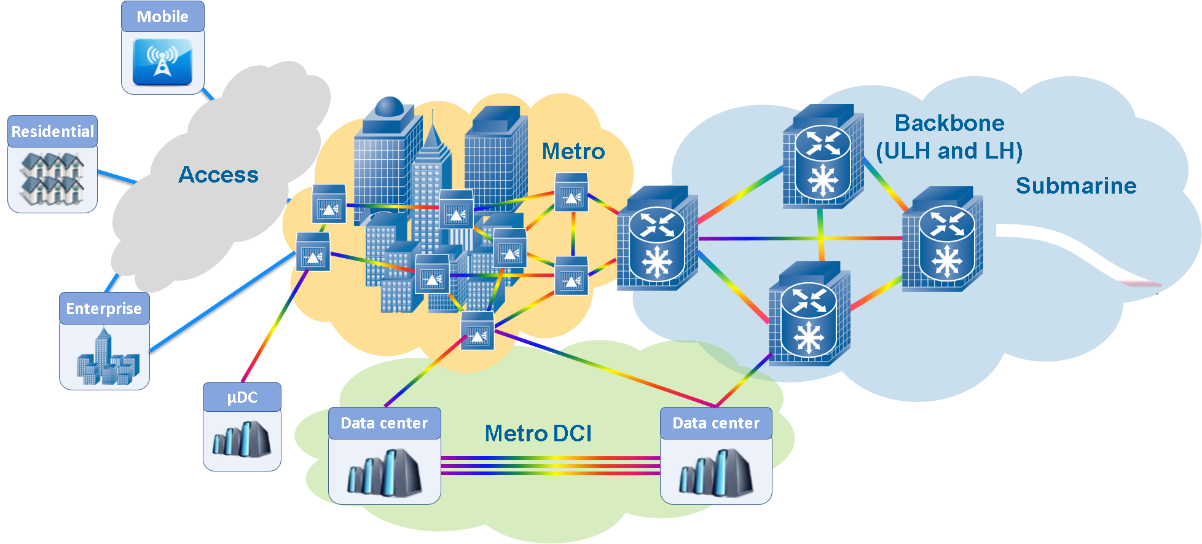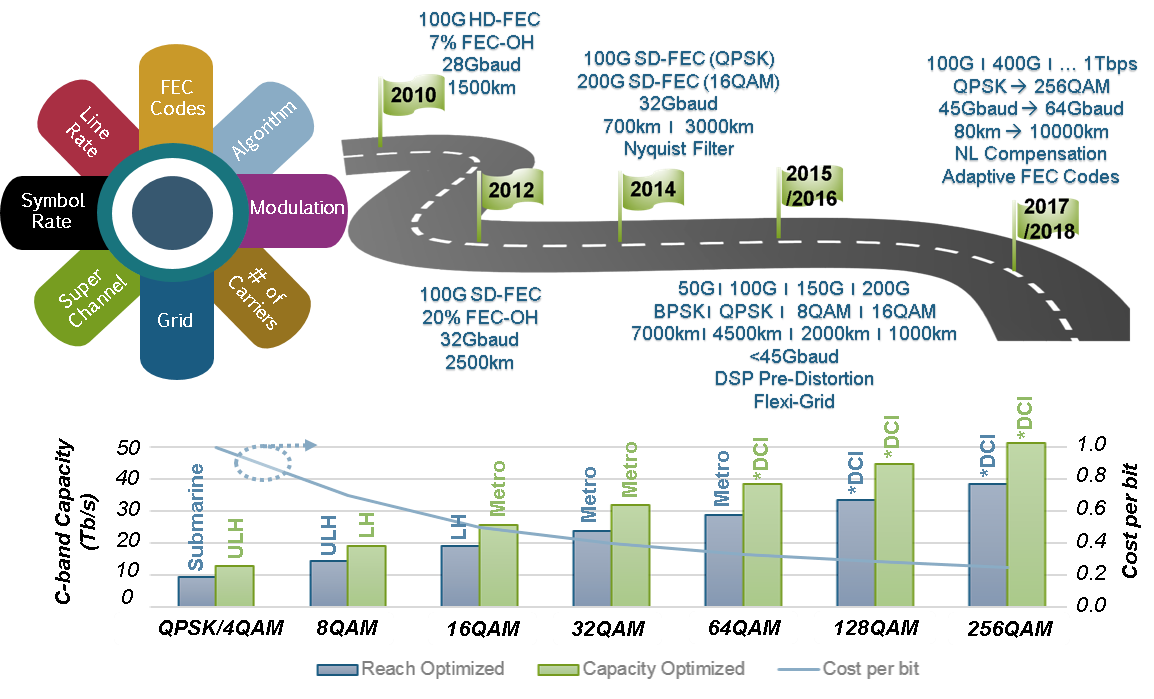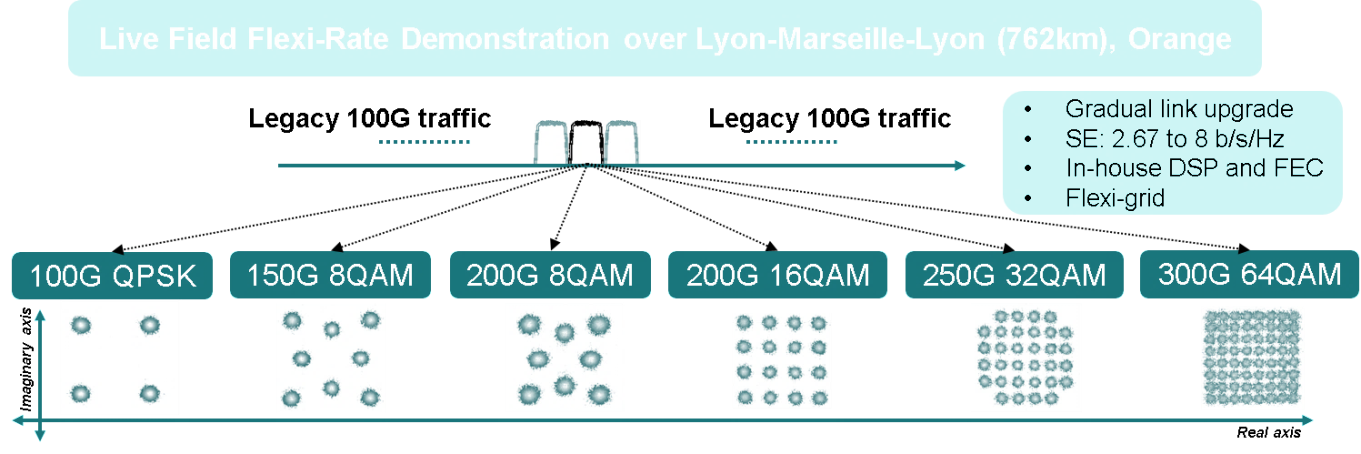by Dr. Danish Rafique and Dr. Maxim Kuschnerov, Coriant




What does the term flexibility signify for the optical transport business? In today’s market space, this is a challenging question, as the degrees of freedom are practically limitless. Over the last decades, the industry has exclusively focused primarily on increasing transport bandwidth or overall capacity per fiber. However, simple bit loading beyond 100G interfaces has resulted in significantly curtailed transmission reach, challenging the industry to shake off the uni-dimensional approach to transport network design. This not only necessitates strategic technology advances to support rising bandwidth demands, but also to understand and exploit the synergy between innovation and service-conscious network evolution. Under these circumstances, the questions then arise as to which applications can leverage new interconnectivity architectures. To what extent does the transponder need to be flexible? What is the impact on legacy platforms, and associated CAPEX/OPEX?
The following is a look at how a new breed of flexi-rate/flexi-grid technologies will ultimately transform the way network operators plan and implement high-speed transport networks.
The Swiss Army Knife Transponder: Technologies and Tradeoffs
The introduction of flexible terminal equipment, allowing dynamic network design and functionality, is a big leap forward from traditional static network operations. The goal is not only to simply introduce a new set of technologies, but to remain cost-competitive and win customers by aiming at the right network application (Figure 1). Unfortunately, the majority of the industry learnt this the hard way when 200G 16QAM flexible coherent platforms were introduced in 2014 as a sole successor to 100G, promising double the transport capacity on the same chip, however failing to do so in the originally targeted core network space. Follow-up products targeted additional flexibility, addressing sweet spots in most core networks with the intermediate modulation scheme 150G 8QAM. A close inspection reveals that these platforms offer the right evolutionary path to true transponder flexibility, as the multi-format architecture synergizes the transport capacity with the appropriate network application, consequently hitting the early-stage flexibility sweet spot.
Figure 1. Optical transport network domains
Figure 2 (top) extends the concept of first-generation flexible line interfaces, introducing the flexible Swiss Army Knife Transponder, a multi-flex platform, enabling full programmability and flexibility, alongside the desired bandwidth upturn beyond 200G. The technology choices include multi-format solutions –allowing line-rates ranging from conventional 100G to 1T and beyond, to adaptive coding schemes and advanced signal processing algorithms. These advanced technology tools consolidate both traditional telecommunication carriers and over-the-top (OTT) content providers, and furthermore allow for scalable and dynamic bandwidth and service provisioning.
Figure 2. The Multi-flex transponder: Technology options, C-band capacity,
costs, and applications in optical transport networks. (*Inter-city)
costs, and applications in optical transport networks. (*Inter-city)
It is important to understand that in this era, it is not about a scrimmage between the optical layer and the DSP chipset functionality, but about how the overall architecture is cost-effectively developed to target a range of network applications. Figure 2 (bottom) presents a consolidated view on applications of various modulation schemes, considering C-band capacity and network domains – based on transmission distance and cost. It is clear that while lower-order modulation will remain the workhorse for niche ultra-long haul links, the most vibrant part of network will range from short reach Data Center Interconnect (DCI) to core/backbone networks, where tradeoffs of higher-order traffic will come into play.
It is worth noting that the industry is already witnessing a shift from largely static platforms as different applications continue to necessitate diverse and ever evolving requirements on form factor, cost per bit and per light path, transport capacity, power consumption, and time-to-market, etc.
Coriant Field Trial at Orange, France: Multi-Flex in Action
How far in the future are these Swiss Army Knife Transponders then? Are equipment vendors serious about it, or is it just another overly hyped topic? The short and rather sweet answer is that the technology and architectures are already being rigorously tested in live field environments. As shown in Figure 3, first prototypes were recently showcased by Coriant, together with the Tier 1 network operator Orange, where a fully flexible transponder was shown to be operational over a live link connecting cities of Lyon and Marseille, spanning a distance of over 750 kilometers.
Figure 3: Live field demonstration of a Swiss Army Knife Transponder over the Orange network in France
Looking closer at the details of the field trial, multiple modulation formats and line rates were propagated over 750 km, using technologies discussed in Figure 2. The trial not only marked 1T line rates but, uniquely, also showcased switchable transmission of QPSK to 64QAM over 750km, emulating an alien traffic upgrade scenario. These results assert the prospect of the concept and underlying technologies of flexible transceivers, where C-band capacity of 38.4T was achieved using 64QAM, quadruple of commercial 100G interfaces, over metro/regional-type distances.
So, is 64QAM the new 16QAM? The answer is both yes and no, as it depends on the target application scenario. For instance, while 16QAM is typically positioned as a capacity workhorse with moderate transmission reach, 64QAM may beat it for short-reach ultra high capacity solutions, conversely, for market segments bridging distances beyond 100km, 16QAM may still be a format of choice. In general, we would argue against this uni-dimensional thought process, and stress on the flexibility of the transponder, together with streamlined architecture and implementation.
Multi-Flex Transceivers and SDN/NFV: The Bigger Picture
As revenue streams become challenged, service providers are cautious in making decisions on technology upgrades and future network deployments, in part out of fear locking their investments to a new and widely hyped technology. Considering the bigger picture, SDN and NFV are two of the latest industry trends which go hand-in-hand with the concept of flexible transceivers, enabling the management of the entire network (Layer 0 up) through a centralized control system. The key drivers behind these solutions are openness, time-to-market, and CAPEX. This is where the industry needs to make a shift in their thinking, deviating from closed vendor-locked platforms to faster, cheaper, and more open interfaces. Similar to other technology industries, the differentiator need not be technology per se, but how one leverages it as a unit.
One thing is clear - the way forward to flexible transceivers is not a linear evolution of the conventional design cycle. Figure 4 (left) shows a few technologies which may serve as an enabler for flexible transceiver platforms, based on their performance, programmability, and cost. The conventional approach of multiple vendors going after in-house ASIC chipsets is often considered a performance efficient solution; however, it is also the least favorable in terms of time-to-market, and potentially the most expensive option. On the other end of the horizon sits multi-core CPU- and GPU-based processing units, highly flexible and cheap, but with a downside of performance and power dissipation. Taking these tradeoffs into account, it is likely that a dynamic open-source solution will be required in the near future. In this context, ASSP may fit the bill, being able to perform specialized functions across multiple network domains, at the same time being interoperable with multiple system vendors.
Figure 4. Technologies and tradeoffs for fully flexible Network (left). Migration actions
and associated timelines for optical transport networks
and associated timelines for optical transport networks
The industry is quickly adopting the first-generation of flexible transceivers in the form of flexi-rate and flexi-grid solutions. At this point in time there is a growing recognition of dynamic network services, necessitating full programmability and flexibility of transport resources across the entire transport layer stack with, for example, standard-based OpenFlow interfaces down to the transport layer. Figure 4 (right) illustrates migration actions for near term, medium term, and long term deployments, and associated CAPEX/OPEX requirements. Given the scale of this migration, it must follow a gradual roadmap, carefully streamlining the architecture, and making it future-proof. The choice of architecture – considering the tradeoff between OPEX and CAPEX or return on investments in a given market space – will be the secret sauce behind the new deployments.
All in all, the optical transport business is entering into an interesting phase of reform and consolidation. While the industry is breaking away from the traditional mindset, the key to success in future high-capacity optical connectivity will lie in opening up Pandora’s Box of flexibility, while still being able to reasonably tame the complexity underneath. The openness of future optical platforms must go hand-in-hand with an easy deployment, intuitive operation and easy scalability across multiple network domains. The next war in telecom will be won at the orchestration layer of connectivity and switching, but can only be enabled by a truly flexible and feature-rich interface design.
Got an idea for a Blueprint column? We welcome your ideas on next gen network architecture.
See our guidelines.
See our guidelines.
















